
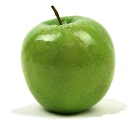

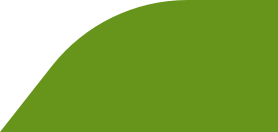
Helping you make healthy choices for you and your family

Breast Cancer is by far the most common cancer among women in Britain with over 47,693 new cases diagnosed in 2008 (Cancer Research UK).
The numbers affected have risen by 80% in the past 30 years but it is believed that 90% of cases are caused by diet and lifestyle. This means that in the majority of cases, breast cancer could be prevented.
This article provides information about self examination, what to look for and diet and lifestyle recommendations to minimise breast cancer risk.
Breast Awareness
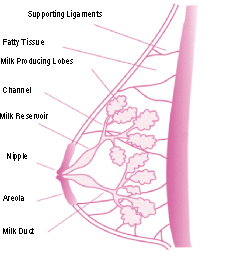
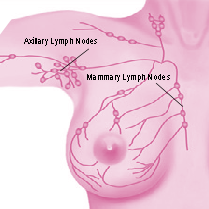
Each breast contains 15—20 groups of glands designed to produce milk. Channels from each gland join up and each group has a main duct which opens at the nipple. The glands are situated in fatty tissue and can normally be felt within the breasts.
Each breast also has a network of lymph vessels and nodes which drain fluid and carry waste products from the tissues. Axillary lymph nodes are found in the armpit and Mammary lymph nodes lie along each side of the breast bone.
By checking your breasts regularly, you will soon become aware of what is normal for you, throughout the month. It is quite normal to have lumpy breasts but if in doubt, always feel the other breast to see if it is the same. If it is not, then it is wise to see your GP.
Many women have one breast slightly larger than the other. Unless there is a noticeable change in size of one breast, there is no need to be concerned.
If you are still menstruating, it is best to check your breasts a few days after your period when they are less lumpy. It is also advisable to check them around the same time each month to get a true indication of any changes.

Benign Breast Conditions
Fibroadenoma is the most likely type of lump if you are under 30. It is caused by an over-development of fibrous tissue and varies in size. Fibroadenomas are harmless and rarely develop into cancer. They generally stay the same size, but if they get larger they are often removed to allay anxiety.
Breast Cysts tend to appear in women in their 40s and 50s. They are fluid-filled sacs in the breast tissue and are characterised by sudden appearance, often associated with pain. There may be several in one or both breasts. The cysts may resolve themselves or your doctor may draw off fluid using a hypodermic needle and once the fluid has gone,the cyst usually disappears. Multiple cysts have a habit of coming back, but once the diagnosis has been established, they can be treated by drawing off the fluid, again.
Pain is the most common breast problem suffered by women and can occur on its own or with breast lumps or lumpiness. Many women experience pain in their breasts before a period and there is some evidence that this may be due to reduced levels of certain essential fatty acids. Taking gamolenic acid (GLA) throughout the cycle has been found to help 58 per cent of cases. Also, breast pain has been found to improve by not wearing a bra.
Types of Breast Cancer
Ductal Carcinoma in Situ (DCIS) is often found on a mammogram. It is a lump of abnormal cells confined to a milk duct. This may not develop into cancer.
Invasive Ductal Carcinoma is the most common type of breast cancer, when cancer cells break free from the milk duct and invade surrounding tissues. This type of lump is usually removed by a surgeon.
Invasive Lobular Carcinoma is less common and develops in a lobule. It can spread to other parts of the body requiring more extensive treatment.
Inflammatory Breast Cancer is rare (1 - 4%). It appears suddenly and the cancer cells block lymph channels in the breast. The breast becomes red and swollen and the nipple may be inverted or discharge fluid.
Self Examination of Your Breasts
If you are familiar with the appearance of your own breasts, you will soon spot any changes. Be aware that the texture may vary throughout your menstrual cycle.
Just remember that nine out of ten women referred to a breast clinic do not have cancer. And the two thirds of women who are diagnosed are alive and well five years later and beyond. Early detection and treatment of cancer gives the greatest chance of survival.
Disclaimer: The information in this article should not be regarded as medical advice. If you are receiving medical treatment or taking prescribed medication, you are advised to consult your GP or health practitioner before making any changes to your diet or lifestyle.
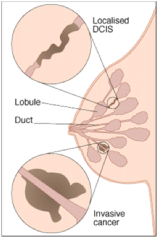
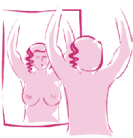
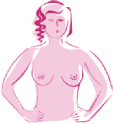

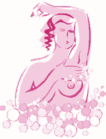
1) Take a look at yourself in the mirror whilst undressing or washing, with your hands by your side, and then with them lifted above your head.
2) Notice the shape of your breasts, any difference between the two sides, the position and direction of the nipples.
3) If you are familiar with the appearance of your own breasts, you will soon spot any changes
4) As you wash your breasts, lying in the bath or standing under the shower, run your soapy hand over each breast with your fingers straight, using the pads of your middle three fingers, then up into the armpit
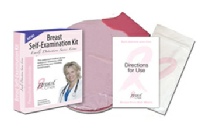
What to check for:
|
|
Any change in the shape or size of either breast
|
|
|
Any change in the shape or position of either nipple
|
|
|
Any flaking, bleeding or discharge from the nipples
|
|
|
Any unusual dimpling or puckering of the skin
|
|
|
Any unusual lumps or thickening of the tissue
|
|
|
Any feelings of pain or discomfort
|
Many women find self examination quite difficult or even intimidating which means that they do not check their breasts regularly. However, a new medical device is helping to change that. Called the Breast Chek, it consists of a layer of oil between two sheets of polyurethane. When placed over each breast, any lump that may be present is magnified and detected much earlier than normal. (see http://www.pulsescreening.co.uk/breast_chek.html
Should you discover any abnormality, it is advisable to speak to your doctor. He or she will determine if you need to be seen by a specialist. If there is any suspicion of cancer, you should be seen within 2 weeks.
You may be sent for a mammogram or ultrasound depending on your age. These will help to screen for physical lumps. Another, less well-known method for screening is Thermography, which checks for hot spots in the breast that may indicate an abnormality. Thermography is also an excellent, non-invasive, early screening method for women under 50. For information about thermography, see http://www.pulsescreening.co.uk/thermography.html.
Prevention
Here are some potential ways to help reduce breast cancer risk:
D
I
E
T
L
I
F
E
S
T
Y
L
E

What to minimise or avoid
|
|
Hydrogenated vegetable fat/oil
|
|
|
All margarines and butter substitutes
|
|
|
Milk products
|
|
|
Processed food and takeaways
|
|
|
Alcohol > one unit a day
|
|
|
Sugar
|
|
|
Artificial sweeteners and additives
|
|
|
Soy products (except fermented soy)
|

What to eat
|
|
5+ Fruits and Vegetables a day
|
|
|
Eggs
|
|
|
Nuts and seeds
|
|
|
Small amount of meat
|
|
|
Oily fish
|
|
|
Garlic
|
|
|
Drink 2 litres of filtered water daily
|
|
|
Supplements: Multivitamin & Mineral formula, Probiotic formula, Omega 3 & 6 (plant source)
|

What to minimise or avoid
|
|
Smoking
|
|
|
Contraceptive Pill and HRT
|
|
|
Excess radiation -
|
|
|
Electro Magnetic Fields -
|
|
|
Oestrogen Mimics -
|
|
|
Stress
|
|
|
Being overweight
|

What to do
|
|
Get active/Exercise > 3 x a week
|
|
|
Have more children!
|
|
|
Breast feed for at least 9 months
|
|
|
Get 10 minutes of sun each day (Vit D)
|
|
|
Wear a correctly fitted bra
|
|
|
Monthly breast self-
|
|
|
Get 8 hours of sleep a night
|
| Your Health Your Future |
| Controversial Ingredients |
| Nutritional State |
| Parent and Child |
| Microwave Ovens |
| Recommended Books |
| Skin Absorption |
| Sodium Lauryl Sulphate |
| Propylene Glycol |
| DEA, MEA, TEA |
| Chemical Calculator |
| Fluoride |
| Aspartame |
| Fluoridation |
| Water Filtration |
| Planning a Pregnancy |
| Pregnancy Care |
| Post Pregnancy Care |
| Amazon Books |
| EBooks |
| About Us |
| Health Services |
